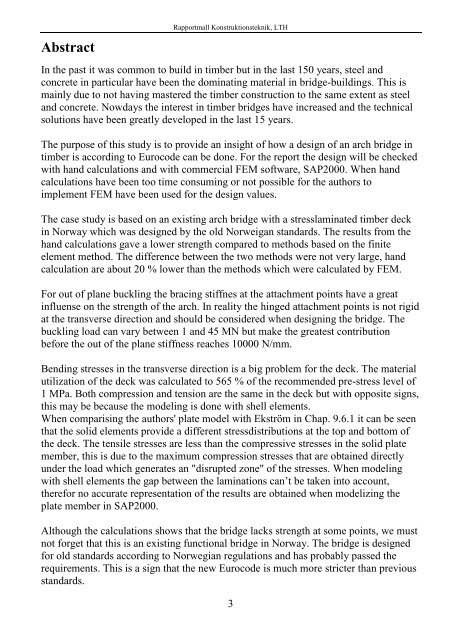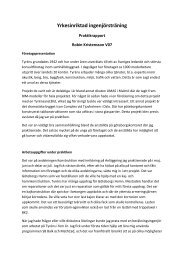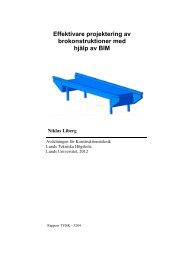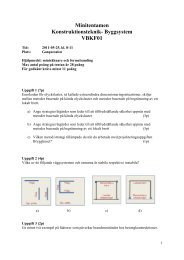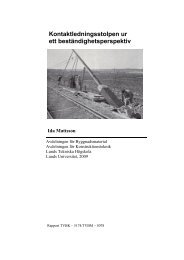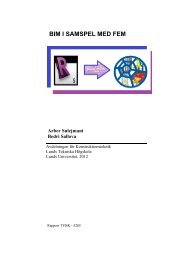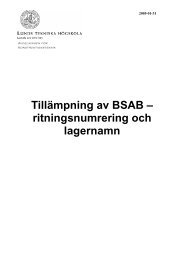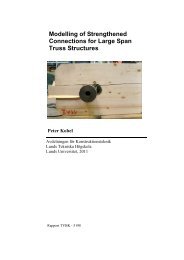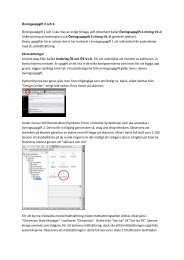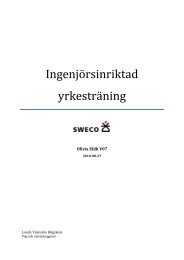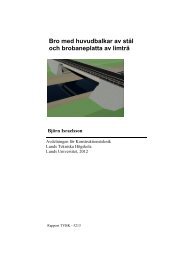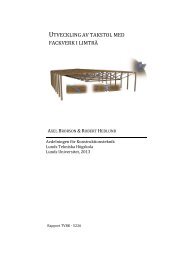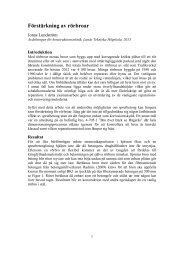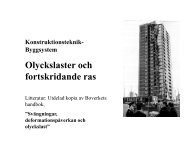Dimensionering av en bågbro i trä - Konstruktionsteknik - Lunds ...
Dimensionering av en bågbro i trä - Konstruktionsteknik - Lunds ...
Dimensionering av en bågbro i trä - Konstruktionsteknik - Lunds ...
You also want an ePaper? Increase the reach of your titles
YUMPU automatically turns print PDFs into web optimized ePapers that Google loves.
AbstractRapportmall <strong>Konstruktionsteknik</strong>, LTHIn the past it was common to build in timber but in the last 150 years, steel andconcrete in particular h<strong>av</strong>e be<strong>en</strong> the dominating material in bridge-buildings. This ismainly due to not h<strong>av</strong>ing mastered the timber construction to the same ext<strong>en</strong>t as steeland concrete. Nowdays the interest in timber bridges h<strong>av</strong>e increased and the technicalsolutions h<strong>av</strong>e be<strong>en</strong> greatly developed in the last 15 years.The purpose of this study is to provide an insight of how a design of an arch bridge intimber is according to Eurocode can be done. For the report the design will be checkedwith hand calculations and with commercial FEM software, SAP2000. Wh<strong>en</strong> handcalculations h<strong>av</strong>e be<strong>en</strong> too time consuming or not possible for the authors toimplem<strong>en</strong>t FEM h<strong>av</strong>e be<strong>en</strong> used for the design values.The case study is based on an existing arch bridge with a stresslaminated timber deckin Norway which was designed by the old Norweigan standards. The results from thehand calculations g<strong>av</strong>e a lower str<strong>en</strong>gth compared to methods based on the finiteelem<strong>en</strong>t method. The differ<strong>en</strong>ce betwe<strong>en</strong> the two methods were not very large, handcalculation are about 20 % lower than the methods which were calculated by FEM.For out of plane buckling the bracing stiffnes at the attachm<strong>en</strong>t points h<strong>av</strong>e a greatinflu<strong>en</strong>se on the str<strong>en</strong>gth of the arch. In reality the hinged attachm<strong>en</strong>t points is not rigidat the transverse direction and should be considered wh<strong>en</strong> designing the bridge. Thebuckling load can vary betwe<strong>en</strong> 1 and 45 MN but make the greatest contributionbefore the out of the plane stiffness reaches 10000 N/mm.B<strong>en</strong>ding stresses in the transverse direction is a big problem for the deck. The materialutilization of the deck was calculated to 565 % of the recomm<strong>en</strong>ded pre-stress level of1 MPa. Both compression and t<strong>en</strong>sion are the same in the deck but with opposite signs,this may be because the modeling is done with shell elem<strong>en</strong>ts.Wh<strong>en</strong> comparising the authors' plate model with Ekström in Chap. 9.6.1 it can be se<strong>en</strong>that the solid elem<strong>en</strong>ts provide a differ<strong>en</strong>t stressdistributions at the top and bottom ofthe deck. The t<strong>en</strong>sile stresses are less than the compressive stresses in the solid platemember, this is due to the maximum compression stresses that are obtained directlyunder the load which g<strong>en</strong>erates an "disrupted zone" of the stresses. Wh<strong>en</strong> modelingwith shell elem<strong>en</strong>ts the gap betwe<strong>en</strong> the laminations can’t be tak<strong>en</strong> into account,therefor no accurate repres<strong>en</strong>tation of the results are obtained wh<strong>en</strong> modelizing theplate member in SAP2000.Although the calculations shows that the bridge lacks str<strong>en</strong>gth at some points, we mustnot forget that this is an existing functional bridge in Norway. The bridge is designedfor old standards according to Norwegian regulations and has probably passed therequirem<strong>en</strong>ts. This is a sign that the new Eurocode is much more stricter than previousstandards.3


